Wenbo Zhang
MOSS-Speech: Towards True Speech-to-Speech Models Without Text Guidance
Oct 02, 2025



Abstract:Spoken dialogue systems often rely on cascaded pipelines that transcribe, process, and resynthesize speech. While effective, this design discards paralinguistic cues and limits expressivity. Recent end-to-end methods reduce latency and better preserve these cues, yet still rely on text intermediates, creating a fundamental bottleneck. We present MOSS-Speech, a true speech-to-speech large language model that directly understands and generates speech without relying on text guidance. Our approach combines a modality-based layer-splitting architecture with a frozen pre-training strategy, preserving the reasoning and knowledge of pretrained text LLMs while adding native speech capabilities. Experiments show that our model achieves state-of-the-art results in spoken question answering and delivers comparable speech-to-speech performance relative to existing text-guided systems, while still maintaining competitive text performance. By narrowing the gap between text-guided and direct speech generation, our work establishes a new paradigm for expressive and efficient end-to-end speech interaction.
PET2Rep: Towards Vision-Language Model-Drived Automated Radiology Report Generation for Positron Emission Tomography
Aug 06, 2025Abstract:Positron emission tomography (PET) is a cornerstone of modern oncologic and neurologic imaging, distinguished by its unique ability to illuminate dynamic metabolic processes that transcend the anatomical focus of traditional imaging technologies. Radiology reports are essential for clinical decision making, yet their manual creation is labor-intensive and time-consuming. Recent advancements of vision-language models (VLMs) have shown strong potential in medical applications, presenting a promising avenue for automating report generation. However, existing applications of VLMs in the medical domain have predominantly focused on structural imaging modalities, while the unique characteristics of molecular PET imaging have largely been overlooked. To bridge the gap, we introduce PET2Rep, a large-scale comprehensive benchmark for evaluation of general and medical VLMs for radiology report generation for PET images. PET2Rep stands out as the first dedicated dataset for PET report generation with metabolic information, uniquely capturing whole-body image-report pairs that cover dozens of organs to fill the critical gap in existing benchmarks and mirror real-world clinical comprehensiveness. In addition to widely recognized natural language generation metrics, we introduce a series of clinical efficiency metrics to evaluate the quality of radiotracer uptake pattern description in key organs in generated reports. We conduct a head-to-head comparison of 30 cutting-edge general-purpose and medical-specialized VLMs. The results show that the current state-of-the-art VLMs perform poorly on PET report generation task, falling considerably short of fulfilling practical needs. Moreover, we identify several key insufficiency that need to be addressed to advance the development in medical applications.
Chain-of-Action: Trajectory Autoregressive Modeling for Robotic Manipulation
Jun 11, 2025Abstract:We present Chain-of-Action (CoA), a novel visuo-motor policy paradigm built upon Trajectory Autoregressive Modeling. Unlike conventional approaches that predict next step action(s) forward, CoA generates an entire trajectory by explicit backward reasoning with task-specific goals through an action-level Chain-of-Thought (CoT) process. This process is unified within a single autoregressive structure: (1) the first token corresponds to a stable keyframe action that encodes the task-specific goals; and (2) subsequent action tokens are generated autoregressively, conditioned on the initial keyframe and previously predicted actions. This backward action reasoning enforces a global-to-local structure, allowing each local action to be tightly constrained by the final goal. To further realize the action reasoning structure, CoA incorporates four complementary designs: continuous action token representation; dynamic stopping for variable-length trajectory generation; reverse temporal ensemble; and multi-token prediction to balance action chunk modeling with global structure. As a result, CoA gives strong spatial generalization capabilities while preserving the flexibility and simplicity of a visuo-motor policy. Empirically, we observe CoA achieves the state-of-the-art performance across 60 RLBench tasks and 8 real-world manipulation tasks.
SemiSAM+: Rethinking Semi-Supervised Medical Image Segmentation in the Era of Foundation Models
Feb 28, 2025



Abstract:Deep learning-based medical image segmentation typically requires large amount of labeled data for training, making it less applicable in clinical settings due to high annotation cost. Semi-supervised learning (SSL) has emerged as an appealing strategy due to its less dependence on acquiring abundant annotations from experts compared to fully supervised methods. Beyond existing model-centric advancements of SSL by designing novel regularization strategies, we anticipate a paradigmatic shift due to the emergence of promptable segmentation foundation models with universal segmentation capabilities using positional prompts represented by Segment Anything Model (SAM). In this paper, we present SemiSAM+, a foundation model-driven SSL framework to efficiently learn from limited labeled data for medical image segmentation. SemiSAM+ consists of one or multiple promptable foundation models as generalist models, and a trainable task-specific segmentation model as specialist model. For a given new segmentation task, the training is based on the specialist-generalist collaborative learning procedure, where the trainable specialist model delivers positional prompts to interact with the frozen generalist models to acquire pseudo-labels, and then the generalist model output provides the specialist model with informative and efficient supervision which benefits the automatic segmentation and prompt generation in turn. Extensive experiments on two public datasets and one in-house clinical dataset demonstrate that SemiSAM+ achieves significant performance improvement, especially under extremely limited annotation scenarios, and shows strong efficiency as a plug-and-play strategy that can be easily adapted to different specialist and generalist models.
Inference Computation Scaling for Feature Augmentation in Recommendation Systems
Feb 22, 2025Abstract:Large language models have become a powerful method for feature augmentation in recommendation systems. However, existing approaches relying on quick inference often suffer from incomplete feature coverage and insufficient specificity in feature descriptions, limiting their ability to capture fine-grained user preferences and undermining overall performance. Motivated by the recent success of inference scaling in math and coding tasks, we explore whether scaling inference can address these limitations and enhance feature quality. Our experiments show that scaling inference leads to significant improvements in recommendation performance, with a 12% increase in NDCG@10. The gains can be attributed to two key factors: feature quantity and specificity. In particular, models using extended Chain-of-Thought (CoT) reasoning generate a greater number of detailed and precise features, offering deeper insights into user preferences and overcoming the limitations of quick inference. We further investigate the factors influencing feature quantity, revealing that model choice and search strategy play critical roles in generating a richer and more diverse feature set. This is the first work to apply inference scaling to feature augmentation in recommendation systems, bridging advances in reasoning tasks to enhance personalized recommendation.
SegAnyPET: Universal Promptable Segmentation from Positron Emission Tomography Images
Feb 20, 2025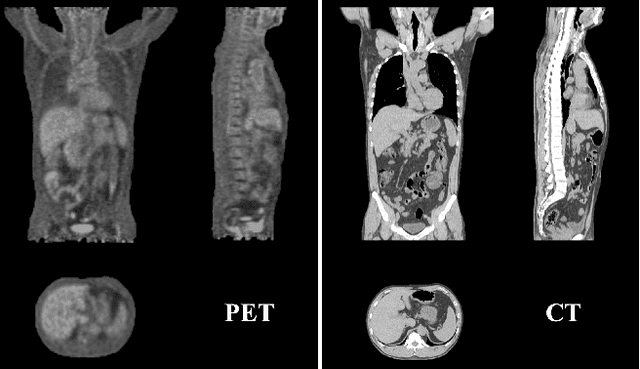
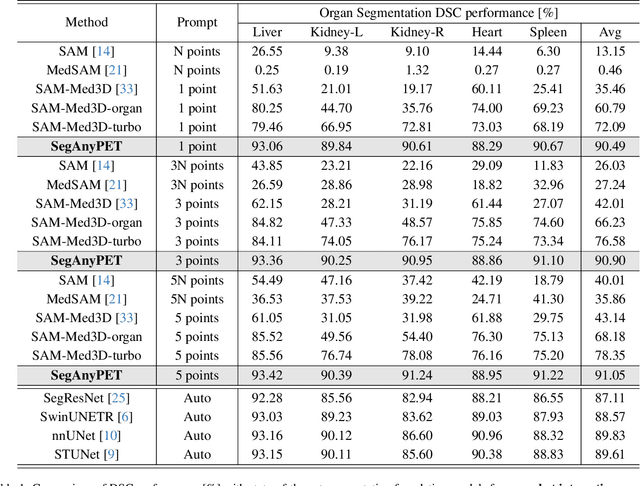
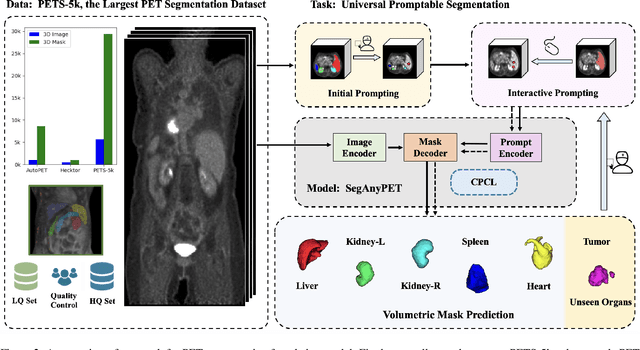
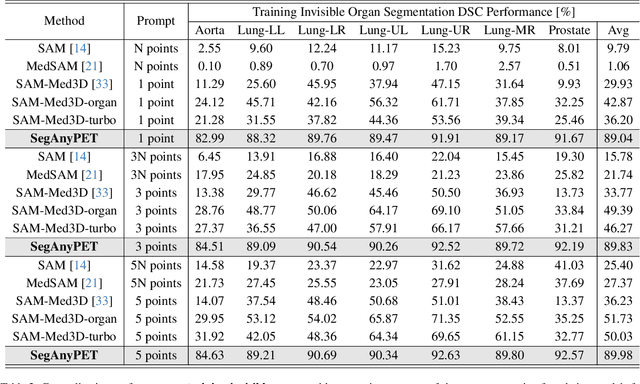
Abstract:Positron Emission Tomography (PET) imaging plays a crucial role in modern medical diagnostics by revealing the metabolic processes within a patient's body, which is essential for quantification of therapy response and monitoring treatment progress. However, the segmentation of PET images presents unique challenges due to their lower contrast and less distinct boundaries compared to other structural medical modalities. Recent developments in segmentation foundation models have shown superior versatility across diverse natural image segmentation tasks. Despite the efforts of medical adaptations, these works primarily focus on structural medical images with detailed physiological structural information and exhibit poor generalization ability when adapted to molecular PET imaging. In this paper, we collect and construct PETS-5k, the largest PET segmentation dataset to date, comprising 5,731 three-dimensional whole-body PET images and encompassing over 1.3M 2D images. Based on the established dataset, we develop SegAnyPET, a modality-specific 3D foundation model for universal promptable segmentation from PET images. To issue the challenge of discrepant annotation quality of PET images, we adopt a cross prompting confident learning (CPCL) strategy with an uncertainty-guided self-rectification process to robustly learn segmentation from high-quality labeled data and low-quality noisy labeled data. Experimental results demonstrate that SegAnyPET can correctly segment seen and unseen targets using only one or a few prompt points, outperforming state-of-the-art foundation models and task-specific fully supervised models with higher accuracy and strong generalization ability for universal segmentation. As the first foundation model for PET images, we believe that SegAnyPET will advance the applications to various downstream tasks for molecular imaging.
Beyond the Singular: The Essential Role of Multiple Generations in Effective Benchmark Evaluation and Analysis
Feb 13, 2025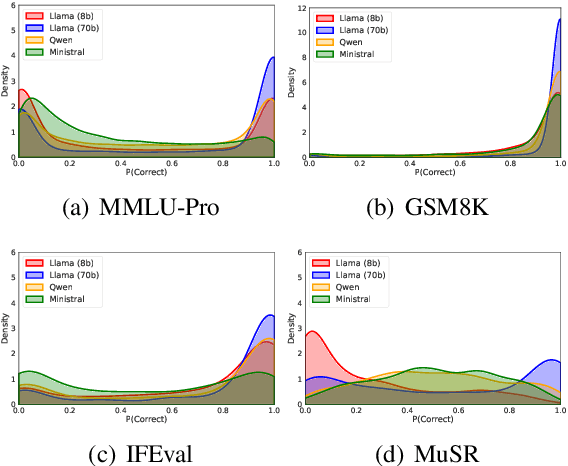
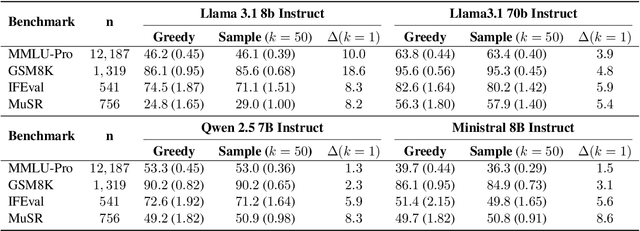
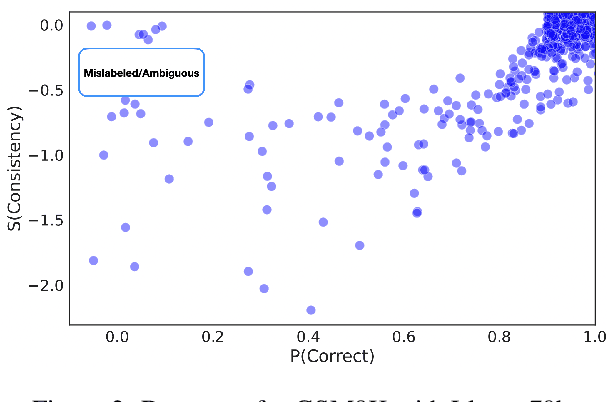
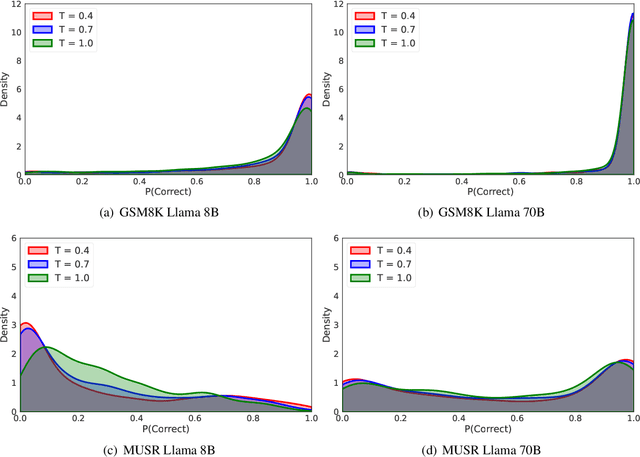
Abstract:Large language models (LLMs) have demonstrated significant utilities in real-world applications, exhibiting impressive capabilities in natural language processing and understanding. Benchmark evaluations are crucial for assessing the capabilities of LLMs as they can provide a comprehensive assessment of their strengths and weaknesses. However, current evaluation methods often overlook the inherent randomness of LLMs by employing deterministic generation strategies or relying on a single random sample, resulting in unaccounted sampling variance and unreliable benchmark score estimates. In this paper, we propose a hierarchical statistical model that provides a more comprehensive representation of the benchmarking process by incorporating both benchmark characteristics and LLM randomness. We show that leveraging multiple generations improves the accuracy of estimating the benchmark score and reduces variance. We also introduce $\mathbb P\left(\text{correct}\right)$, a prompt-level difficulty score based on correct ratios, providing fine-grained insights into individual prompts. Additionally, we create a data map that visualizes difficulty and semantic prompts, enabling error detection and quality control in benchmark construction.
Adaptive Pruning for Large Language Models with Structural Importance Awareness
Dec 19, 2024



Abstract:The recent advancements in large language models (LLMs) have significantly improved language understanding and generation capabilities. However, it is difficult to deploy LLMs on resource-constrained edge devices due to their high computational and storage resource demands. To address this issue, we propose a novel LLM model pruning method, namely structurally-aware adaptive pruning (SAAP), to significantly reduce the computational and memory costs while maintaining model performance. We first define an adaptive importance fusion metric to evaluate the importance of all coupled structures in LLMs by considering their homoscedastic uncertainty. Then, we rank the importance of all modules to determine the specific layers that should be pruned to meet particular performance requirements. Furthermore, we develop a new group fine-tuning strategy to improve the inference efficiency of LLMs. Finally, we evaluate the proposed SAAP method on multiple LLMs across two common tasks, i.e., zero-shot classification and text generation. Experimental results show that our SAAP method outperforms several state-of-the-art baseline methods, achieving 2.17%, 2.37%, and 2.39% accuracy gains on LLaMA-7B, Vicuna-7B, and LLaMA-13B. Additionally, SAAP improves the token generation speed by 5%, showcasing its practical advantages in resource-constrained scenarios.
INSIGHT: Explainable Weakly-Supervised Medical Image Analysis
Dec 02, 2024
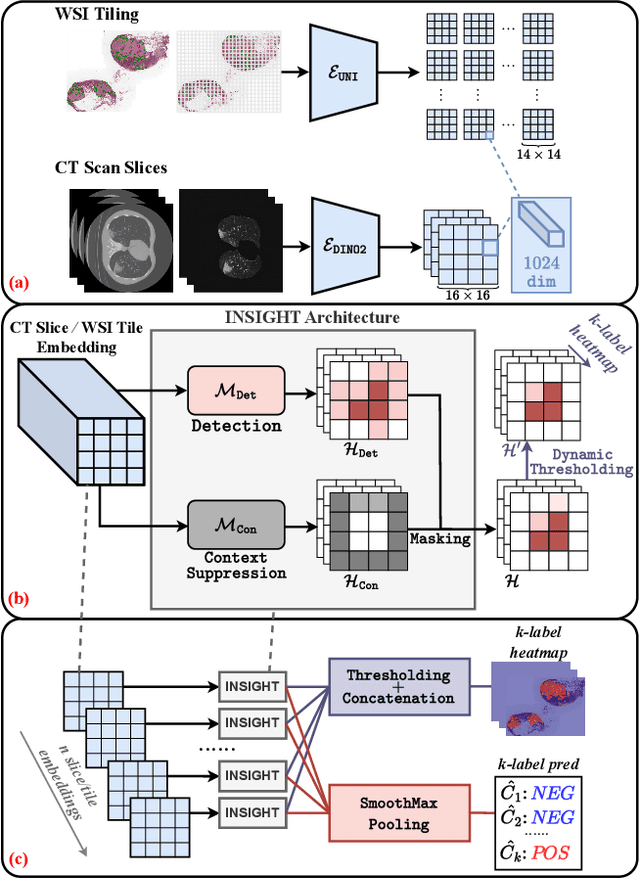
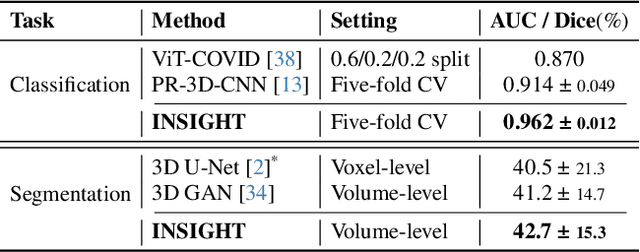

Abstract:Due to their large sizes, volumetric scans and whole-slide pathology images (WSIs) are often processed by extracting embeddings from local regions and then an aggregator makes predictions from this set. However, current methods require post-hoc visualization techniques (e.g., Grad-CAM) and often fail to localize small yet clinically crucial details. To address these limitations, we introduce INSIGHT, a novel weakly-supervised aggregator that integrates heatmap generation as an inductive bias. Starting from pre-trained feature maps, INSIGHT employs a detection module with small convolutional kernels to capture fine details and a context module with a broader receptive field to suppress local false positives. The resulting internal heatmap highlights diagnostically relevant regions. On CT and WSI benchmarks, INSIGHT achieves state-of-the-art classification results and high weakly-labeled semantic segmentation performance. Project website and code are available at: https://zhangdylan83.github.io/ewsmia/
Bootstraping Clustering of Gaussians for View-consistent 3D Scene Understanding
Nov 29, 2024Abstract:Injecting semantics into 3D Gaussian Splatting (3DGS) has recently garnered significant attention. While current approaches typically distill 3D semantic features from 2D foundational models (e.g., CLIP and SAM) to facilitate novel view segmentation and semantic understanding, their heavy reliance on 2D supervision can undermine cross-view semantic consistency and necessitate complex data preparation processes, therefore hindering view-consistent scene understanding. In this work, we present FreeGS, an unsupervised semantic-embedded 3DGS framework that achieves view-consistent 3D scene understanding without the need for 2D labels. Instead of directly learning semantic features, we introduce the IDentity-coupled Semantic Field (IDSF) into 3DGS, which captures both semantic representations and view-consistent instance indices for each Gaussian. We optimize IDSF with a two-step alternating strategy: semantics help to extract coherent instances in 3D space, while the resulting instances regularize the injection of stable semantics from 2D space. Additionally, we adopt a 2D-3D joint contrastive loss to enhance the complementarity between view-consistent 3D geometry and rich semantics during the bootstrapping process, enabling FreeGS to uniformly perform tasks such as novel-view semantic segmentation, object selection, and 3D object detection. Extensive experiments on LERF-Mask, 3D-OVS, and ScanNet datasets demonstrate that FreeGS performs comparably to state-of-the-art methods while avoiding the complex data preprocessing workload.
 Add to Chrome
Add to Chrome Add to Firefox
Add to Firefox Add to Edge
Add to Edge